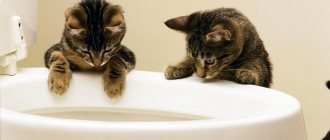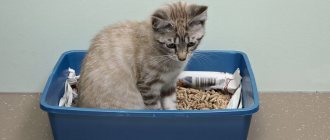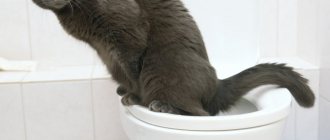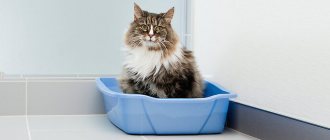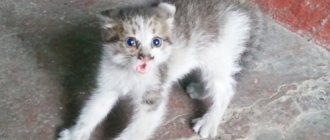The Scottish Straight (Scottish Straight) and Scottish Fold (Scottish Fold) breeds have high intelligence, but this does not mean that they do not need to be trained. From childhood, babies are taught to use a litter box, otherwise they get used to relieving themselves in inappropriate places.
To make the upbringing process easy and comfortable, you should take a responsible approach to the choice of toilet and filler. And also arm yourself with a few tricks that experienced owners use.
It all starts with the breeder
How to train a Scottish kitten to use the litter box? In general, the breeder should do this before the baby moves to a new home. Owners adopt a kitten when it reaches 2-2.5 months, by which time the pet is litter box trained. At least that's what the ideal option looks like.
In life, things happen differently; a kitten is bought before 2 months of age. Often he is barely 1-1.5 months old when the baby is separated from his mother. Such a baby does not yet have the skills to use the tray independently. How to accustom a Scottish kitten to the litter box if he arrived at his new home when he was very young? There are several methods, which are described below.
When does a Scottish kitten begin to go to the toilet on its own?
While the kittens are newborns, all toilet issues are decided by their mother. They go about their little ones on their own, and the cat also helps them go about the big ones: she licks the anus area of her babies with her tongue to stimulate defecation, after which she washes their butts. But these are the first weeks. Some kittens are already trying out the tray before they are a month old, while others still don’t understand what’s what. Starting from a month, cats already move around the apartment over certain distances and can pee somewhere without permission. Although from birth they already see that their mother goes to the litter box, and ideally they themselves try to imitate her. However, if the seals are somewhere far away at the moment when the urge occurs, they will not be able to tolerate it (unlike adult cats) and will make a puddle. By 2-2.5 months, cats should already know their potty. It is not recommended to take them away from their mother before this period, including in order not to suffer from toilet problems.
Selecting a tray and filler
This subsection is short but informative. It will be useful for those who are getting a kitten for the first time.
When purchasing a tray, you should pay attention to tanks with high sides. They are good because the filler does not scatter in all directions when the pet carefully buries its waste. An excellent option would be a closed tray made in the shape of a house. These cat litter boxes are equipped with a special door so that your pet feels comfortable while in them. At first, when the kitten is small, the door can be removed.
As for the filler, many owners of “Scots” actively use silica gel. They absorb liquid well, forming small lumps that are convenient for cleaning. The package is enough for a month if you keep one cat.
How to stop shitting around the apartment?
The British favorite begins to play dirty tricks out of a feeling of discontent or revenge. First you need to find the root of the problem. So, if a cat has become accustomed to pooping in a corner or on the bed, then most likely the pet does not like the tray or litter. Replacing these two components will solve the problem. Lavender and lemon oil will also help you stop walking on furniture. It is recommended to apply a couple of drops to the headboard and backs of sofas or beds, and the pungent smell will scare cats away from the wrong place.
When a pet refuses to go to the toilet, but every time tries to find a secluded corner and hide its “goods” far away, it means that it is frightened by noises or other people’s looks at the litter box. Purchasing a toilet with a roof, in the form of a house, will be a good option. This behavior is also provoked by a lack of attention from the owner. You need to regularly play and communicate with your pet. And if he goes to the wrong place, you can scold the animal, but not beat him. Otherwise, his motives will be revenge.
Source
Ways to teach cleanliness
How to train a Scottish kitten to use the litter box (female, 2 months old)? Questions like this are very common on cat lovers forums. Newbie owners try to indicate not only the age, but also the gender of their pet.
Toilet training does not depend on the gender of the kitten. The basic rules that contribute to the speedy development of the reservoir are as follows:
- Choosing a temporary location for the tray.
- First acquaintance with him.
- Installing the tank in a permanent place.
- Carefully monitor your pet. As soon as he decides to go to the toilet, the kitten is carried into the tray.
Let's look at each point in detail.
Choosing a temporary location
When a kitten arrives in a new home, it is limited in space. The fact is that the fluffy new baby is too small to immediately remember where the bowl of food, bed or tray is. How to train a Scottish kitten to use the litter box at 2 months? Detailed instructions for the reader:
- Before bringing your pet to your apartment, arrange a place for him to live. One room should contain a bed (house), bowls of food and water, and a cat litter box.
- The baby arrived to new owners. He is introduced to a designated corner in which there is a tray, shown a place to rest, a bowl of food.
- By the time the kitten is introduced to it, there should be filler in the poop container.
In the first 3-4 weeks, while the baby gets used to the new place of residence and gets comfortable, the tray is located not far from the bed and bowls. If you put food in the kitchen and a toilet in a certain room, your pet will get confused and won’t be able to find it.
Education, education and more education
There is one wrong, but quite common opinion. Some owners believe that the kitten is simply too young to do the right thing all the time. And so they silently clean up after the pet, without doing anything to change the situation, without explaining or showing the baby the “right” place. However, the longer such behavior continues, the more difficult it is to retrain the animal. The kitten simply accepts this as the norm and then cannot understand why you are angry with him. If it happens that the kitten did its business in the wrong place, then you should not scold it, poke it with its muzzle or spank it. You just need to take your pet to his tray and put a napkin soaked in a puddle there. The smell will help the baby orientate himself.
As a rule, about a week is enough for the Scottish Fold kitten to get used to his litter box. If this does not happen, then you should pay more attention to the process of training your pet. Try to spend as much time as possible with your kitten, try not to let him out of your sight for long. At the first suspicion that the kitten wants to go to the toilet (shows concern, sits down in secluded places) or some time after eating, you need to take it to the tray and not let go until it finishes, and then be sure to praise and stroke it. With this behavior and attitude and patience, all problems should disappear in a short time.
The tray can be left empty, filled with papers, sand or special filler. Of course, you may not want to spend your money on litter, but very often cats simply refuse to go into an empty litter box. The same thing often happens with trays filled with newspapers or paper. Several times the lop-eared kitten goes into the tray as needed, and then a puddle may still appear in the wrong place. Sometimes sand is taken directly from the street for the tray, but this is strictly not recommended. Why? Because, firstly, there is a lot of all kinds of infection that a pet can pick up. Secondly, the pet’s paws will be dirty and marks will remain on the furniture, bed, etc. Therefore, most cat owners prefer to use various fillers. But here, too, some difficulties may arise. There are situations when a kitten flatly refuses to go to a tray filled with one litter, but goes to another quite well and without problems. Sometimes you have to select a good filler using trial and error.
In addition, in no case should you forget about the cleanliness of the tray. After all, Scottish Fold cats, like any other, are very clean animals and therefore, if you do not wash the litter box on time, you should not be surprised that the cat refuses to visit it and finds another place. Punishing and scolding a cat for not wanting to go to the dirty toilet is completely stupid and pointless. If such a nuisance occurs through your fault, you should definitely and very thoroughly disinfect the place where it happened. Otherwise, there is a danger that the kitten will “visit” this place from time to time. Scottish Fold kittens quickly become accustomed to the litter box if their owners behave correctly.
Installing the tray in a permanent place
Just as described above, you can train a Scottish kitten to use a litter box at 1.5 months. This method is universal, suitable for animals under 3 months of age.
The pet is getting older and has settled into the apartment perfectly. It's time to move the tray into the toilet room and show the four-legged prankster where he now needs to go about his “business”.
The place for the tray is chosen in such a way that the kitten does not have to look for it for a long time. Due to his age, the baby is not always able to control his needs. You can’t scold him for this, just like you can’t rub your nose into the misunderstanding on the floor. The baby will not understand what he has done wrong, he will get scared and stop trusting the owner.
If the baby does not make it to the tray, his excrement is collected using toilet paper and taken to the right place. After putting the scented paper in the tray, the kitten is placed there too. The new location of the tray will be remembered by the pet, he will begin to rush there, as soon as he feels the urge of the body to do this or that thing.
Tray training
This subsection describes how to litter box train a Scottish Fold kitten. There are several ways:
- When purchasing a pet, ask the breeder for some used litter.
- If you see that the baby has gone to the wrong place, follow the description in the previous subsection.
- When the pet begins to fuss and sit down, clearly intending to get rid of waste, he is picked up and quickly placed in a tank with filler.
- The old method from Soviet grandmothers-cat owners. Human urine is applied to a small strip of newspaper, plain paper, or toilet paper. It is placed in the cat's litter box and the pet is placed there as well. The smell will let him know that excrement is being disposed of in this place.
- The pet is placed in a tray with clean filler and given the opportunity to dig into it. It is believed that in this way the need to hide the waste of one’s life is awakened.
What you need to know about trays
Buy a bigger tray
Your kitten will grow up quickly, and if one day the tray turns out to be too small for him, the pet can go around the house looking for a larger toilet. In this case, the height of the sides should be such that the animal can climb into it on its own.
Please note that trays can be closed or open.
Both models have their pros and cons. On the one hand, a closed tray gives the animal a sense of privacy. On the other hand, the walls retain odors and the cat may refuse to use a tray that is not, in his opinion, clean enough. In addition, it is not very convenient for large animals in such a tray to turn around and bury traces of their vital activity.
Tom Thai / flickr.com
Open trays also come in different types: with mesh, without mesh, with high and low sides. A tray with high edges is good for an adult animal that likes to rummage through the litter too vigorously and scatter it in all directions. At the training stage, it will not be easy for a small kitten to climb into such a tray.
But a low tray with a mesh can be very useful. The filler in this model is poured under the removable part and does not come into contact with the paws
Perhaps your kitten will not immediately object to the mesh, and if it turns out that it is vital for him to rummage through the litter, the top part can be removed permanently or temporarily
There are also special toilet covers that are good for everyone, except for one thing: they are not suitable for small kittens, pregnant cats and old or sick animals. But if you really like the idea of accustoming your animal to the toilet and not having to fuss with the litter, you can try this pad when the kitten grows up.
litterkwitterlee.blogspot.ru
Many of these pads are gradual toilet training systems, using rings of varying diameters that are removed as the animal becomes accustomed. Some of them (like this one) can be filled with filler first. Which system is right for your pet depends on his preferences.
Finally, there are fully automatic cat litter boxes that clean themselves and are therefore very convenient and hygienic. But such a miracle of technology is quite expensive. At the same time, there is a chance that it will scare you or your pet simply won’t like it.
urbanpetproducts.com.au
Make sure you have a spare tray
This doesn't happen often, but be prepared for the fact that some cats prefer to urinate in one litter box and defecate heavily in another. If you live in a house or apartment with several floors, each floor should have a cat litter box.
And of course, if you have several cats, each should have its own litter box.
Choose a suitable location
The cat litter area should be easily accessible, convenient and fairly quiet. It is better not to place the tray in the farthest corner of the house: in case of emergency, the kitten may not have time to reach it.
Possible problems
Options for teaching a Scottish kitten to go to the litter box are described above. However, it also happens that the owner has tried all the methods, but the pet categorically refuses to visit the “thoughtful corner.” Let's consider the possible reasons for this behavior and methods for eliminating them:
- Plastic smell from the tray. A person is not able to catch it, the animal reacts very sensitively. On cat lovers' forums, you can often find posts about how your pet runs away from the litter box like it's on fire. Especially when the tank is cheap and made in China. What should the owner do in such a case? How to train a Scottish kitten to use the litter box? Wash the tank with hot water and soap several times, rinse and let dry. If this method does not help, then you will have to change the cat litter.
- Bad filler, the kitten prefers the more familiar one. The owner thinks that sawdust for the cat litter box is a decent option. It's cheap, the consumption is small, it absorbs the smell - what else do you need? It turns out that the purebred pet has his own view on this issue. Living with a breeder, he got used to stony litter, sand or silica gel. It is useless to convince your pet, because then fragrant piles will be found in places that are completely unsuitable for these purposes. It’s easier to change the filler and forget about the problem.
- How to train a Scottish kitten to use a litter box if the animal does not like its location. There are also whims when a representative of the breed chooses another corner to suit his needs, ignoring the tank with filler. The problem can be easily solved if the tray is moved to the selected location.
Frequent difficulties
The reason for not going to the litter box may be its color or shape.
Raising a British pet is not easy, especially if a person is experiencing it for the first time. There are a number of difficulties that owners of luxury pets often face. It happens that a stubborn cat has chosen another place for his toilet and flatly refuses to relieve his needs in the tray. In this case, there are two options to solve the problem. Firstly, the owner can make concessions: put the tray in a favorite place. But if such a rearrangement is impossible, then block access to this place for the cat. It happens that the cat simply does not like this tray. He may remind her of something unpleasant. Then only buying a new toilet can help. If this applies specifically to the filler, then it is worth replacing it.

